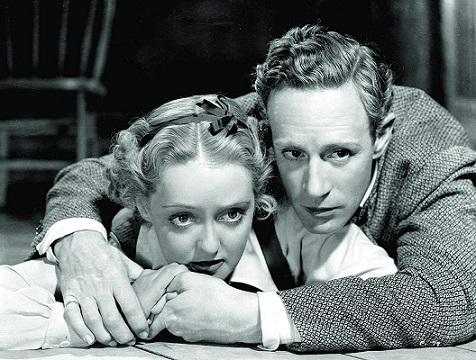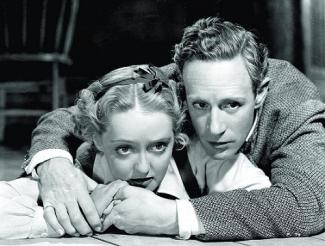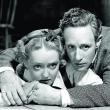Gangsters reign in Warner Bros. collection
Ultimate Gangsters Collection: Classics (1931-1949, Warner Bros., 4 Blu-rays + DVD, NR, 357 min.). This is a reissue of a 2013 set that includes four classic films and a feature-length documentary. The films are “Little Caesar,” with Edward G. Robinson, and “The Public Enemy,” with James Cagney, from 1931; “The Petrified Forest,” with Humphrey Bogart, Leslie Howard and Bette Davis, from 1936; and “White Heat,” with Cagney, from 1949. The DVD documentary that looks at the whole genre of gangster films released by Warner Bros., is “Public Enemies: The Golden Age of the Gangster Film.”
In “Little Caesar” (78 min., 3.25 stars), Robinson (“Key Largo,” “Double Indemnity”) plays Caesar Enrico “Rico” Bandello and sets the mark for the tough gangster, who usually shoots first and does not really care about an answer. His prime goal is to move up the mob ladder until he is the one giving the orders.
The film starts with a gas station robbery – these days of high gas prices, drivers often think it is the station doing the robbing – and ends with Rico, after reaching control of the whole North Side of Chicago, being shot down by police while he is a broke, penniless man.
Through most of his gang ascension, Rico is accompanied by Joe Massara (Douglas Fairbanks Jr. of “Sinbad, the Sailor,” “The Prisoner of Zenda,” “The Legend of Robin Hood”), but once they reach Chicago, Joe is more interested in his nightclub dance act with partner Olga Stassoff (Glenda Farrell of “Blondes at Work,” “Gold Diggers of 1937”). Rico even decides to rob the nightclub where Joe works, and shoots Crime Commission head Alvin McClure (Landers Stevens of “Hell Drivers”) in the process.
Rico is a non-drinker, but he sure takes advantage of Prohibition, when public liquor consumption was outlawed but the law was generally ignored. One classic scene, later mirrored on courthouse steps in “The Godfather,” has mob car driver Tony Passa (William Collier Jr. of “Broadminded,” “Speed Demon”) gunned down on the steps of a church, as he felt bad about the nightclub robbery.
Robinson brings relentless energy to the otherwise rather flaccid film. The film did receive one Oscar nomination, for Best Writing, Adaptation by Francis Edward Faragoh and Robert N. Lee. The director was Mervyn LeRoy (“Mister Roberts,” “Quo Vadis,” “Gypsy”).
The film comes with audio commentary by film historian Richard B. Jewell; the featurette “Little Caesar: End of Rico, Beginning of the Antihero,” which traces the place of the film in film history and the gangster genre (17:09; it points out Rico was based on Al Capone); and the Warner Night at the Movies, 1930 that includes a newsreel (1:47), the Merrie Melodies cartoon “Lady, Play Your Mandolin” (7:17) and the Hell’s Kitchen Depression short, “The Hard Guy” (6:28), starring a young Spencer Tracy.
More iconic was Cagney (“Angels with Dirt Faces,” “The Roaring Twenties”) as gangster Tom Powers in “The Public Enemy” (84 min., 3.25 stars), with his shocking treatment of women, as when he pushes half a grapefruit into the face of girlfriend Kitty (Mae Clarke of “Frankenstein,” “Waterloo Bridge”).
Based on a true story, with names changed, the film starts with the childhood of Tom and his brother Mike, but Mike is soon replaced by pal Matt Doyle (Edward Woods of “Dinner at Eight”) as they take advantage of Prohibition. Mike (Donald Cook of “Baby Face,” “Show Boat”) enlists in the Marines instead and is very anti-Tom when he gets out. Meanwhile, Tom remains loyal and helpful to his mother (Beryl Mercer of “The Little Princess” as Ma Powers), a theme also in “White Heat.”
Tom has a fun first encounter with Gwen Allen (Jean Harlow of “Red Dust,” “Bombshell”), when he and Matt give her a ride and she says she will call him later, putting a little dance into his steps.
In the liquor game, Tom worked with Samuel “Nails” Nathan, until Nails was thrown and killed by a horse. They buy the horse just so they can kill it -- offscreen of course. In fact, a lot of the violence occurs offscreen.
The film received one Oscar nomination, for Best Writing, Original Story by John Bright and Kubec Glasmon. The director was William A. Wellman (the original “A Star Is Born,” “The Ox-Bow Incident”).
The film comes with audio commentary by film historian Robert Sklar; the feature “Beer and Blood: Enemies of the Public,” including comments by director Martin Scorsese, who hails the film as a masterpiece (19:37) and the Warner Night at the Movies, 1931 that includes a newsreel (1:34), the ventriloquist Edgar Bergen and dummy Charlie McCarthy short “The Eyes Have It” (9:57) and the “Smile, Darn Ya, Smile” Merrie Melodies cartoon (7 min.).
Next is “The Petrified Forest” (87 min., 3.5 stars), which stars Howard and Bogart in the same roles they performed on Broadway. The film opens at a gas station/café in a desolate, windy stretch of road. Multiple tumbleweeds are seen in the few scenes that take place outside of the café, located in northeast Arizona.
Working at the café is Gabrielle “Gabby” Maple (Davis of “All About Eve,” “Dark Victory,” “Whatever Happened to Baby Jane?”), a waitress and would-be painter, who was born in France, while Gramp Maple (Charley Grapewin of “The Wizard of Oz,” “The Grapes of Wrath”) works both in the café and gas station parts. In the latter, he is joined by Boze Hertzlinger (Dick Foran of “The Mummy’s Han,” “Donovan’s Reef”), a young man who would like to court Gabby.
Into the sparsely-attended café comes hitchhiker Alan Squier (Howard of “Pygmalion,” “Gone with the Wind”), a European writer and intellectual who is touring America after a failed marriage. Since Gabby loves books, especially a book of French poetry, she quickly becomes friendly with Alan, even taking him up to the roof of the café to show off some of her paintings. This, of course, makes Boze jealous.
Thirty-nine minutes in, criminal-murderer Duke Mantee, who has been all over the radio news, shows up with three fellow criminals, having stolen the car of the Chisholms (Paul Harvey of “Algiers,” “High Sierra,” “Spellbound” and Genevieve Tobin of “One Hour with You,” “Easy to Love”), who had stopped at the café and had agreed to give Alan a ride. The three of them and their driver eventually walk back to the café, giving Mantee even more hostages.
Boze is very aggressive towards Mantee and his men, Ruby (Adrian Morris of “The Grapes of Wrath,” “Angels with Dirty Faces”), Slim (Slim Thompson of “The Green Pastures,” “Moon Over Harlem”) and Jackie (Joe Sawyer of “A Double Life,” “The Killing”). This leads to trouble, as Mantee waits for his girlfriend and a couple more gang members. The real question is whether the police will arrive first.
Late in the film, Alan makes a very romantic request to Mantee, having fallen for Gabby. The film, with its claustrophobic setting, was directed by Archie Mayo (“The Crimson City”), who agreed with Howard that Bogart should repeat his part rather than Edward G. Robinson, the studio’s choice., or there would be no film. The film helped Bogart move into leading roles as his Mantee is withdrawn, dead-eyed and economical in word and action, unlike Robinson and Gagney’s more outgoing characters in the previous two films. Robert E. Sherwood based the play’s character of Mantee on John Dillinger, and Bogart studied Dillinger to develop his performance.
Extras include audio commentary by Bogart biographer Eric Lax; the feature “The Petrified Forest: Menace in the Desert,” in which scholars and historians discuss the film (15:51); audio of the Jan. 7, 1940 radio Gulf Stream Theater broadcast of the play, starring Joan Bennett, Bogart and Tyrone Power (28:58); and the Warner Night at the Movies, 1936 with a newsreel (3:24), the short “Rhythmitis,” about fabulous dancing (19:37) and the Merrie Melodies cartoon “The Coo Coo Nut Grove” (6:46).
The fourth film in the set is “White Heat” (113 min., 3.75 stars), with gangster son Cody Jarrett, overly in love with his mother (Margaret Wycherly of “Sergeant York” as Ma Jarrett). She is no stay-at-home mother. She is nearly as evil as her son, especially when she sees one of Cody’s gang members (Steve Cochran of “The Best Years of Our Lives,” “Copacabana” as Big Ed Somers) kissing Cody’s wife (Virginia Mayo of “The Best Years of Our Lives,” “A Song Is Born” as Verna Jarrett) and trying to have Cody killed, while he is serving prison time in Illinois.
This brings up what makes the film so interesting. Cody is serving time in Illinois for a hotel robbery he admits to but did not commit. It is his alibi for the $300,00 in U.S. Treasury funds his gang stole from a train – Cody jumps onto the train from the top of a tunnel – in which four were killed. Trying to discover where the money is hidden, Treasury agent Hank Fallon (Edmond O’Brien of “The Man Who Shot Liberty Valance,” “Seven Days in May”) goes undercover as Vic Pardo to get close to Cody in prison. That includes saving Cody’s life and working together on an escape plan.
Despite having $300,000 hidden, Cody, after the escape, decides to rob a chemical plant of its $426,000 payroll, which leads to a massive deadly shootout and a fiery explosion, along with Cagney’s classic closing line of “Made it, Ma. Top of the world.”
The film was inspired by the real-life gangster Arthur "Doc" Barker and his mother Ma Barker, from a suggestion by Cagney himself to the writer, Virginia Kellogg, who earned an Oscar nomination for Best Writing, Motion Picture Story. The director was veteran Raoul Walsh (“The Thief of Bagdad,” “Captain Horatio Hornblower,” “Gentleman Jim”).
Extras include audio commentary by film historian Dr. Drew Cooper; the feature “White Heat: Top of the World,” on the film and its place in Cagney’s career (16:55; includes Mayo’s comments); and the Warner Night at the Movies, 1949, with a newsreel (1:30), the Joe McDoakes short “So You Think You’re Not Guilty” (10:31) and Merry Melodies cartoon “Homeless Hare” (7:06).
The bonus documentary, “Public Enemies: The Golden Age of the Gangster Film” (105 min., 3.25 stars), repeats some of the previous four film examinations and expands upon them and includes director Walsh’s “Regeneration,” considered the first gangster film, plus censorship battles, Jack Warner’s efforts and even a look at “Scarface.” Grade: overall extras 3.25 stars
Rating guide: 5 stars = classic; 4 stars = excellent; 3 stars = good; 2 stars = fair; dog = skip it
Rock Star (2001, Warner Bros., Blu-ray, R, 106 min.). Some might say that Mark Wahlberg was born to play would-be rocker Chris “Izzy” Cole. After all, before his film career, he fronted Marky Mark and the Funky Bunch, as a rapper who sometimes performed in just his underwear, from 1991 to 1993. This film nods to that by including a video snippet of that group’s chart-topping hit, “Good Vibrations,” during the closing credits.
In “Rock Star,” Wahlberg (“Boogie Nights,” “The Departed,” two “Ted” films, “The Departed”) plays Cole, who is the lead singer of a tribute band – not a cover band, he often stresses – of the heavy metal band Steel Dragon. Cole, who repairs copiers during the day, has Steel Dragon’s lead singer’s stage act down pat and even sings notes longer than the original singer. That original singer, Bobby Beers (Jason Flemyng of “Lock, Stock and Two Smoking Barrels,” “Stardust,” TV’s “Primeval”), suddenly is thrown out of the band and Cole is brought to Los Angeles to audition, winning the gig before he sang half a song.
The music is loud and played by some real musicians, including drummer Jason Bonham (Sammy Hagar), Dokken bassist Jeff Pilson and guitarist Zakk Wylde (Ozzy Osbourne) in the Steel Dragon band, along with actor Dominic West (“Tomb Raider,” “Chicago,” TV’s “The Wire”) as the guitarist. The band’s manager Mats is played by Timothy Spall (“Sweeney Todd: The Demon Barber,” TV’s “Wolf Hall”).
Cole’s girlfriend/manager Emily Poule is played by Jennifer Anniston (“We’re the Millers,” TV’s “Friends”) and their tribute band was Blood Pollution, whose lead guitarist Rob Malcolm (Timothy Olyphant of TV’s “Justified,” “Alien: Earth,” “Daisy Jones & The Six”) missed a lot of rehearsals and wanted to start performing his own songs, leading to conflict with Cole.
The latter resonates with Cole later when he brings his potential songs for a Steel Dragon album and they are rejected without even being looked at by the band’s two songwriters. In addition to growing discontent with the gig, Cole’s time in Streel Dragon affects his relationship with Poule, and not in a good way, what with all the band’s partying.
The film is fun, if not too deep. It has a nice, if highly unlikely ending. It was inspired by the true story of Tim Owens, the lead singer in a Judas Priest tribute band, who replaced Rob Halford as lead singer of Judas Priest when Halford left the band. Halford subsequently returned to Judas Priest. Both of the Steel Dragon singers were dubbed; Cole’s vocals are provided primarily by Mike Matijevic, singer for the band Steelheart, while Beers’ vocals are provided by Jeff Scott Soto, singer for Yngwie Malmsteen's band, among others.
Extras include audio commentary by director Stephen Herek (“Critters,” “Mr. Holland’s Opus,” “Bill & Ted’s Excellent Adventure”); an Everclear music video of the title song (3:45); and a behind-the-scenes look (4:04). Grade: film 3 stars; extras 2 stars
The 100: The Complete First Season (2014, Warner Bros., 3 Blu-rays, NR, 544 min.). I really liked this CW science fiction series for most of its seven-season run. Developed by Jason Rothenberg, the series is loosely based on a book series by Kass Morgan and was begun when she only had written two chapters of the first book. The series follows descendants of post-apocalyptic survivors from a space habitat, the Ark, a combination of 12 space stations, who return to Earth 97 years after a devastating nuclear apocalypse.
Faced with declining resources on the Ark, the decision is made to send a group of 100 juvenile delinquents to Earth to see if it is habitable – which it is, although mutations, such as two-headed animals, exist. Among the 100 are Clarke Griffin (Eliza Taylor of TV’s “Neighbours,” “Pirate Island”), the independent daughter of Ark Chief Medical Official Abby Griffin (Paige Turco of TV’s “Person of Interest”); daredevil Finn Collins (Thomas McDonell of “The Prom”); and illegal siblings Bellamy Blake (Bob Morley of TV’s “Home and Away,” “Love Me”) and Octavia Blake (Marie Avgeropoulos of “Tracers”). Other key young adults are Raven Reyes (Lindsey Morgan of TV’s “General Hospital”), John Murphy (Richard Harmon of “Final Destination: Blood Lines,” TV’s “Continuum,” “Fakes”), Monty Green (Christopher Larken of TV’s “Tales of the City”) and Jasper Jordan (Devon Bostick of three “Diary of a Wimpy Kid” films, “Oppenheimer”).
While the 100 try to survive and bury their differences, they discover at least three separate groups of survivors living on Earth. Then, in episode 13, the season’s finale, remnants of the Ark crash land with some adult survivors, including Abby Griffin, Chancellor Thelonius Jaha (Isaiah Washington of “Ghost Ship,” TV’s “Grey’s Anatomy”) and the pragmatic Councilor Marcus Kane (Henry Ian Cusick of TV’s “Lost,” “MacGyver”).
One of the key Earthers is Lincoln (Ricky Whittle of TV’s “American Gods,” “Hollyoaks”). More Earther characters are developed in later seasons.
Extras include four featurettes that make up “Creating the World of The 100.” They are The Beginning (7:13), The Ark (6:37), A New Earth (6:46; woods filming was in northern Vancouver) and Grounders, Reapers and Mountain Men (7:52), as well as two deleted scenes from episode 13 (2:11) and an audio commentary by Rothenberg and director Dean White for the episode, and the show’s 2013 Comic-Con Panel (14:03) with actors Taylor, McDonell, Washington, Cusick and Avgeropoulos, and executive producers Rothenberg and Matt Miller. Grade: season 3.25 stars; extras 2.5 stars
About this blog:

My music review column, Playback, first ran in February 1972 in The Herald newspapers of Paddock Publications in Arlington Heights, IL. It moved to The Camden Herald in 1977 and to The Courier Gazette in 1978, where it was joined by my home video reviews in 1993. The columns ran on VillageSoup for awhile, but now have this new home. I worked at the Courier Gazette for 29 years, half that time as Sports Editor. Recently, I was a selectman in Owls Head for nine years.



























